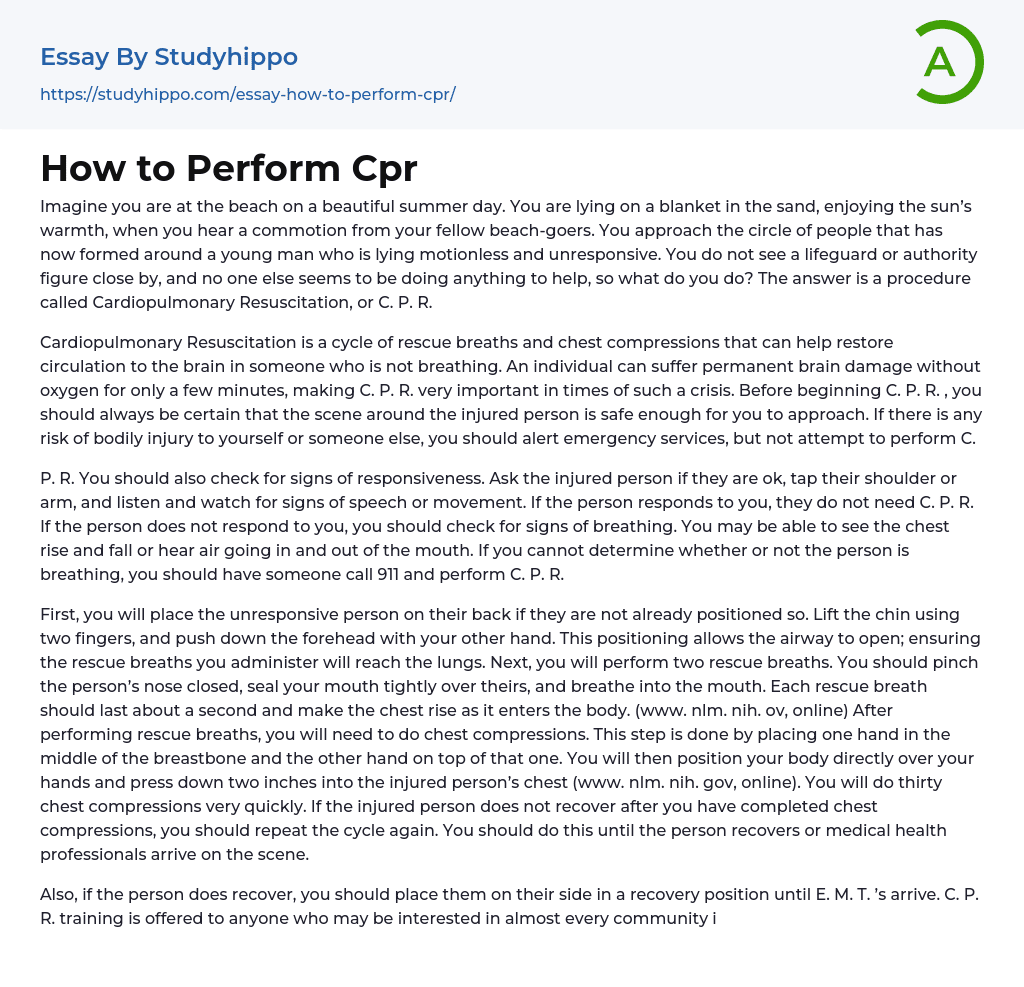Imagine yourself at the beach, enjoying the warmth of the sun on a lovely summer day. Suddenly, you notice some commotion among your fellow beach-goers. Intrigued, you head towards a crowd surrounding a young man who seems to be unconscious and not moving. With no lifeguard or authority figure present and nobody else taking any action, what should you do? The answer lies in a method known as Cardiopulmonary Resuscitation, also referred to as C.P.R.
Cardiopulmonary Resuscitation (C.P.R.), which includes rescue breaths and chest compressions, is crucial for restoring circulation to the brain of someone who is not breathing. If a person goes without oxygen for even a short amount of time, they can experience irreversible brain damage. Therefore, it is essential to prioritize C.P.R. in these situations. However, b
...efore initiating C.P.R., make sure that the surrounding area is safe. If there are any potential risks of injury, it is important to contact emergency services and refrain from attempting C.P.R.
When assessing an injured person's condition, it is important to check for signs of responsiveness and ask if they are alright. Gentle tapping on their shoulder or arm can also be done as well as observing any signs of speech or movement. If the person responds, then C. P. R is not necessary. However, if there is no response, it becomes crucial to check for signs of breathing by looking for chest movements or listening for air intake and release through the mouth. If determining whether the person is breathing becomes difficult, it is essential to have someone immediately call 911 and perform C. P. R.
To begin, it i
important to ensure that the unresponsive person is positioned on their back. If they are not already in this position, gently lift their chin using two fingers while pushing down on their forehead with your other hand. This action helps to open the airway so that the rescue breaths you administer can reach their lungs effectively (www.nlm.nih.gov, online). Next, provide two rescue breaths by pinching the person's nose closed and sealing your mouth tightly over theirs. Breathe into their mouth for about a second each time, observing that the chest rises as the air enters their body.
After administering rescue breaths, it is time to proceed with chest compressions. Place one hand in the middle of the breastbone and position your other hand on top of it. Directly align your body over your hands and press down firmly into the injured person's chest about two inches deep (www.nlm.nih.gov, online). Carry out thirty chest compressions rapidly.
If there is no sign of recovery after performing chest compressions, repeat these steps until medical professionals arrive or until the person recovers.
Placing someone who recovers on their side in a recovery position until E.M.T.'s arrive is important. C.P.R. training is widely available in the United States and provides crucial knowledge that can greatly benefit others. Performing C.P.R. rapidly and efficiently during an emergency can save lives and significantly reduce the risk of brain damage. A combination of chest compressions and rescue breaths offers another opportunity for life to those who require it.
- Cloning essays
- Medical Ethics essays
- Patient essays
- Therapy essays
- drugs essays
- Cannabis essays
- Aspirin essays
- Cardiology essays
- Hemoglobin essays
- Pharmacology essays
- Surgery essays
- alternative medicine essays
- Plastic Surgery essays
- Organ Donation essays
- Vaccines essays
- Medical essays
- Dentist essays
- Psychological Trauma essays
- Physical therapy essays
- Cold essays
- Cocaine essays
- Why Marijuana Should Be Legalized essays
- Drug Abuse essays
- Teenage Drug Abuse essays
- Heart Disease essays
- Artery essays
- Clothing essays
- Cosmetic Surgery essays
- Fashion design essays
- Footwear essays
- Addiction essays
- Anatomy and Physiology essays
- Biodegradation essays
- Cancer essays
- Dental Care essays
- Disability essays
- Disease essays
- Disorders essays
- Health Care essays
- Infectious Disease essays
- Inquiry essays
- Intelligence Quotient essays
- Lung Cancer essays
- Medicine essays
- Neurology essays
- Nutrition essays
- Olfaction essays
- Physical Exercise essays
- Public Health essays
- Sex essays




